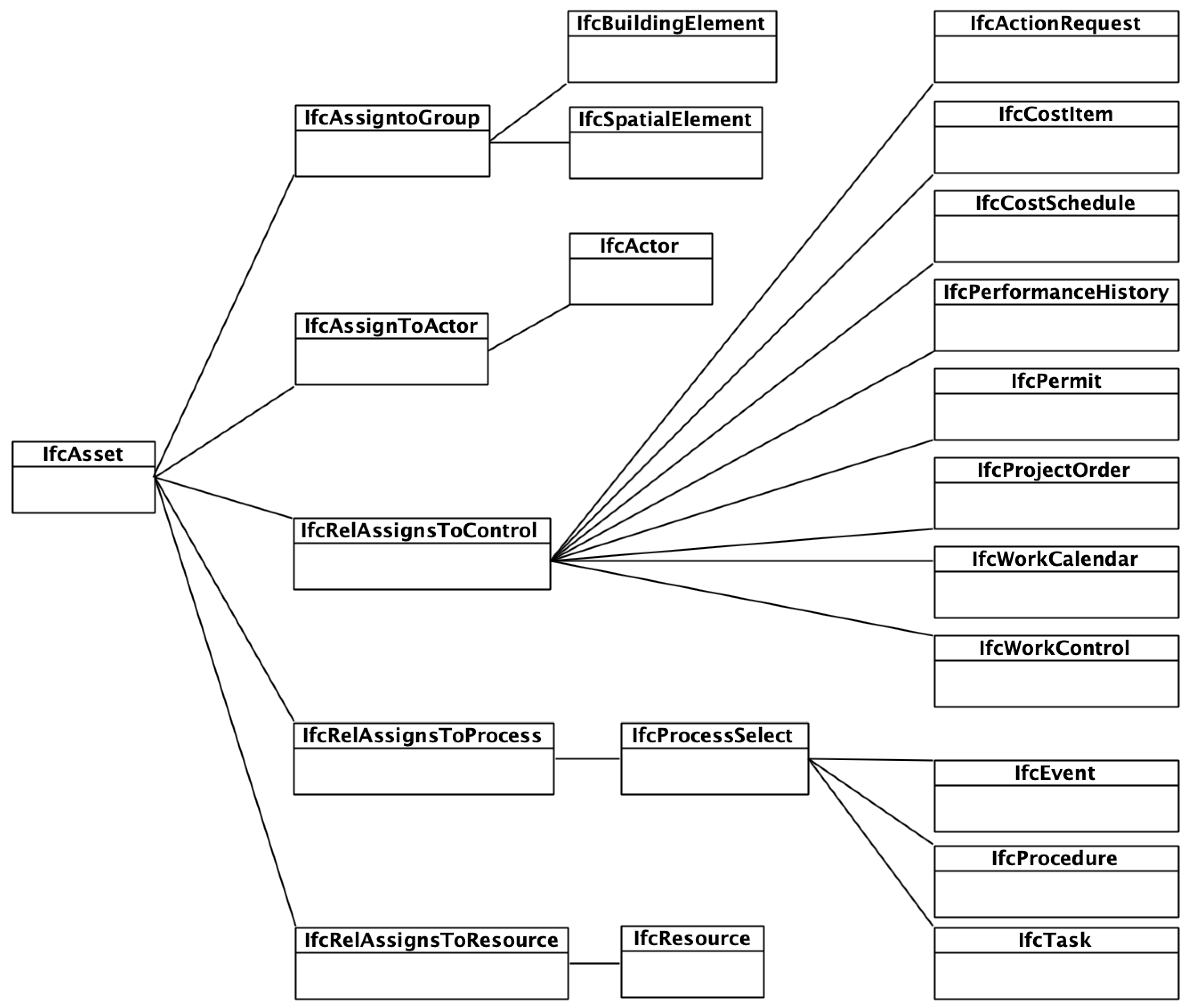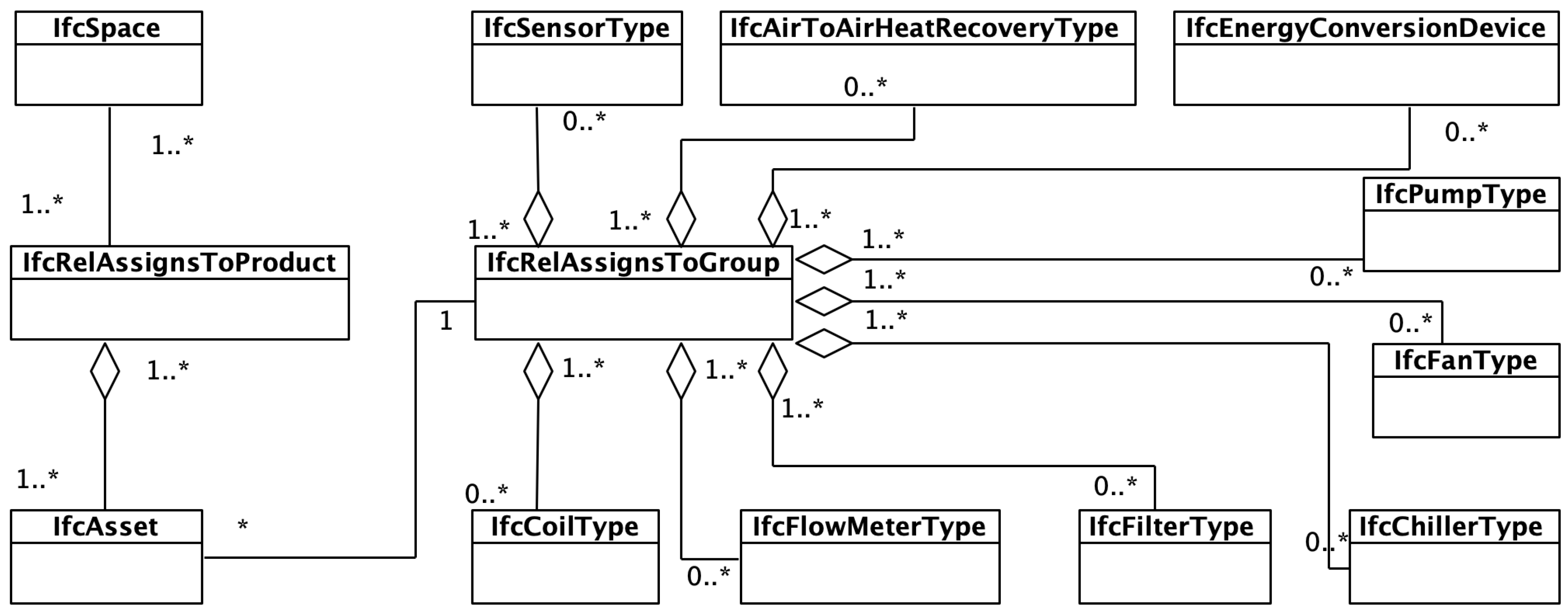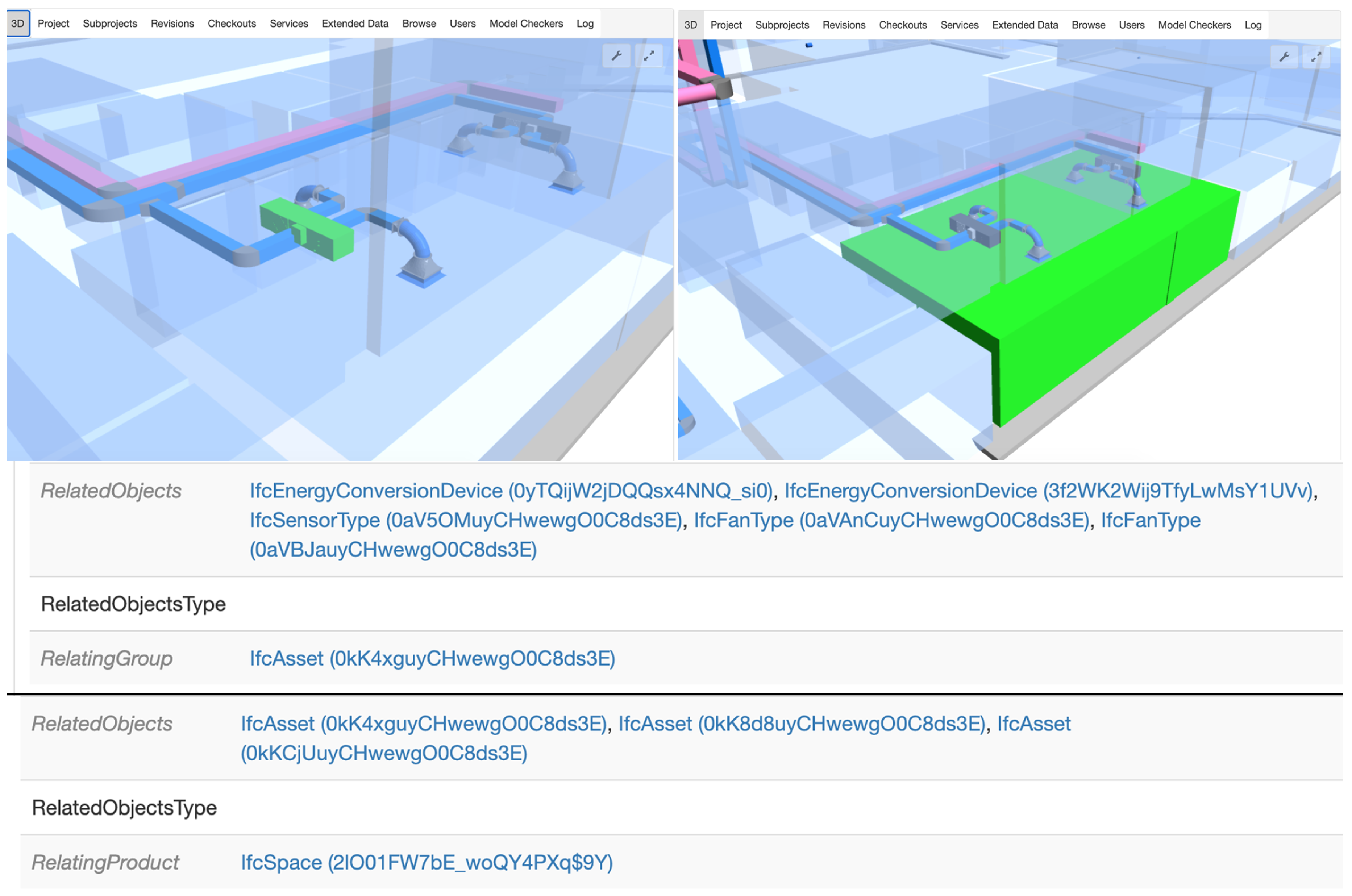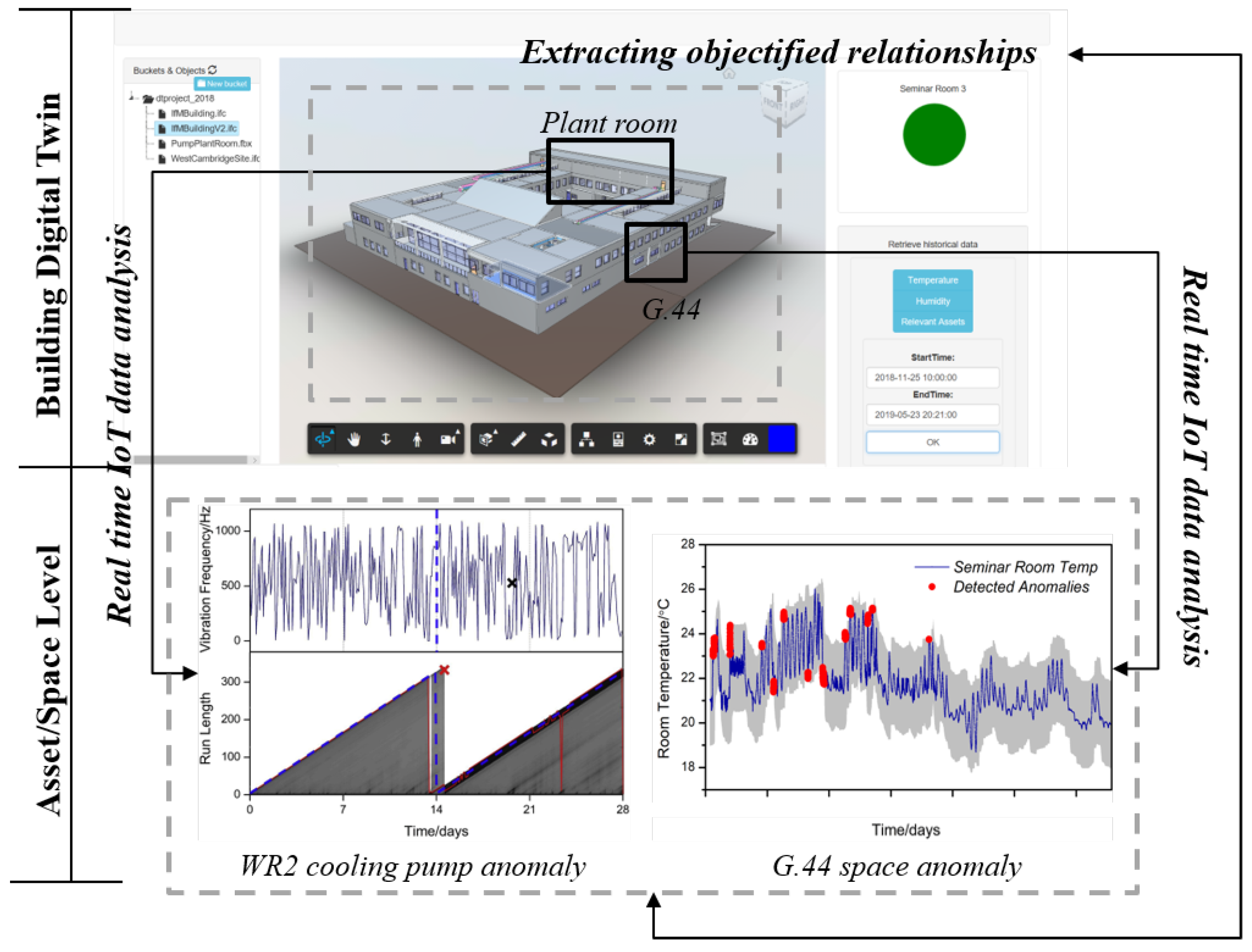An openBIM Approach to IoT Integration with Incomplete As-Built Data
Abstract
Featured Application
Abstract
1. Introduction
1.1. Digital Modelling in Asset Management
1.2. Data Integration Management
- BIM models are often created during the design, manufacturing, and construction phases using unclear procedures, and updated as-built models are hardly accessible or even not available. In addition to the static nature of BIM, outdated and unreliable (i.e., inaccurate and incomplete) building information impedes the full potential of the AM applications during the use phase.
- Even when updated as-built BIM data is available, scarce attention is still paid during the design phase to the information management process across the whole asset life cycle. Consequently, the information requirements (IRs) during the use phase are often not met because of the way information is created and aggregated (e.g., classified), during the design and construction phase. BIM is a flexible modelling approach, which supports the inclusion of geometries, assets and systems as part of the model. However this flexibility may result in chaos if recognisable hierarchies and classification systems are not defined in the design phase and adopted during the assets’ life cycle.
- Static and real-time data are managed differently because of their nature. For instance, some asset information is designed to be static (e.g., asset locations and geometries), whereas asset performance is measured in real-time in DTs throughout the use phase. Static data is not updated frequently (or at all) and is stored in passive repositories (e.g., relational data-bases or files to query or in COBie spreadsheets). Real-time data is variable, requiring special storage and management (e.g., actively publishing new data for active subscribers). IRs are clearly different for static and real-time data, leading to AM applications that cannot use both sources of information.
1.3. Aim of the Paper
- Improved accessibility of the integrated information;
- Users’ profiling and access to the right data at the right moment;
- Dynamic AM application support, with limited as-built information availability and
- Enhanced information quality by better matching with the domain specific requirements from different AM applications.
2. State of the Art
- It improves the quality of building data (e.g., preventing data replication and limiting redundancy and inconsistency);
- It facilitates data integration during the building life cycle;
- It improves communication between stakeholders;
- It enables smoother workflows among involved parties according to standardised procedures;
- It allows a reduction in time and cost in the retrieval of FM related information;
- It enables a faster verification process.
2.1. Uses of the BIM and IoT Technologies
2.2. Integration Architectures
3. The Proposed Openbim Methodology
4. Case Study
- Geometries and location of the HVAC components, including primary air loop, variable refrigerant flow (VRF), water circulation pumps and radiators;
- Relevant data in the civil components of the building (technical specifications, active contracts, maintenance records, models and producer of the components);
- Sensor location and technical specifications;
- System architecture, that is, the way the HVAC system is organised from multiple components, according to a classification system;
- Interface requirements with the real-time platform.
- Set points for the HVAC system (e.g., the temperature of the rooms, relative humidity, CO2 concentration);
- Data on comfort parameters measurements (BMS, Monnit sensors);
- Data on the BMS and IoT sensors status.
5. Discussion
- Flexible schema: Data in the OpenBIM approach is not constraint by a classical relation data schema. A flexible data schema is proposed to facilitate data collection from diverse data sources.
- Standardised metadata: Predefined common metadata attributes to tag data from different sources homogeneously in the data platform. These agreed metadata attributes also enable dynamic data integration and multi-format conversion.
- Real-time perspective: One of the main goals is to enable rapid data transfers by limiting the size of data packages. This reduces the latency of data end-to-end and allows timely decision-making.
6. Conclusions
Author Contributions
Funding
Conflicts of Interest
References
- International Organization for Standardization (ISO). ISO 55000:2014 Asset Management Overview, Principles and Terminology; ISO: Geneva, Switzerland, 2014. [Google Scholar]
- Lu, Q.; Xie, X.; Parlikad, A.K.; Schooling, J.M.; Konstantinou, E. Moving from building information models to digital twins for operation and maintenance. Proc. Inst. Civ. Eng. Smart Infrastruct. Constr. 2020, 1–11. [Google Scholar] [CrossRef]
- Wong, J.K.W.; Ge, J.; He, S.X. Digitisation in facilities management: A literature review and future research directions. Autom. Constr. 2018, 92, 312–326. [Google Scholar] [CrossRef]
- International Organization for Standardization (ISO). EN ISO 19650-1:2018. Organization and Digitization of Information about Buildings and Civil Engineering Works, Including Building Information Modelling (BIM)—Information Management Using Building Information Modelling. Part 1: Concepts and Principles; ISO: Geneva, Switzerland, 2018. [Google Scholar]
- International Organization for Standardization (ISO). EN ISO 19650-2:2018. Organization and Digitization of Information about Buildings and Civil Engineering Works, Including Building Information Modelling (BIM)—Information Management Using Building Information Modelling. Part 2: Delivery Phase of the A; ISO: Geneva, Switzerland, 2018. [Google Scholar]
- International Organization for Standardization (ISO). EN ISO 19650-3:2020. Organization and Digitization of Information about Buildings and Civil Engineering Works, Including Building Information Modelling (BIM)—Information Management Using Building Information Modelling; ISO: Geneva, Switzerland, 2018. [Google Scholar]
- Royal Institute of British Architects (RIBA). RIBA Plan of Work 2020 Overview; Technical Report; RIBA: London, UK, 2020. [Google Scholar] [CrossRef]
- Patacas, J.; Dawood, N.; Kassem, M. BIM for facilities management: A framework and a common data environment using open standards. Autom. Constr. 2020, 120, 103366. [Google Scholar] [CrossRef]
- Moretti, N.; Re Cecconi, F. A cross-domain decision support system to optimize building maintenance. Buildings 2019, 9, 161. [Google Scholar] [CrossRef]
- Chen, C.J.; Chen, S.Y.; Li, S.H.; Chiu, H.T. Green BIM-based building energy performance analysis. Comput. Aided Des. Appl. 2017, 14, 650–660. [Google Scholar] [CrossRef]
- Wong, J.K.W.; Zhou, J. Enhancing environmental sustainability over building life cycles through green BIM: A review. Autom. Constr. 2015, 57, 156–165. [Google Scholar] [CrossRef]
- Santos, R.; Costa, A.A.; Silvestre, J.D.; Pyl, L. Integration of LCA and LCC analysis within a BIM-based environment. Autom. Constr. 2019, 103, 127–149. [Google Scholar] [CrossRef]
- Ding, L.; Drogemuller, R.; Akhurst, P.; Hough, R.; Bull, S.; Linning, C. Towards sustainable facilities management. In Technology, Design and Process Innovation in the Built Environment; Taylor & Francis: London, UK, 2009; pp. 373–392. [Google Scholar]
- Jourdan, M.; Meyer, F.; Bacher, J.P. Towards an integrated approach of building-data management through the convergence of Building Information Modelling and Internet of Things. J. Phys. Conf. Ser. Inst. Phys. Publ. 2019, 1343, 12135. [Google Scholar] [CrossRef]
- Tang, S.; Shelden, D.R.; Eastman, C.M.; Pishdad-Bozorgi, P.; Gao, X. A review of building information modeling (BIM) and the internet of things (IoT) devices integration: Present status and future trends. Autom. Constr. 2019, 101, 127–139. [Google Scholar] [CrossRef]
- Bolton, A.; Butler, L.; Dabson, I.; Enzer, M.; Evans, M.; Fenemore, T.; Harradence, F.; Keaney, E.; Kemp, A.; Luck, A.; et al. The Gemini Principles; CDBB: Cambridge, UK, 2018. [Google Scholar]
- BuildingSMART International. Enabling an Ecosystem of Digital Twins. A buildingSMART International Positioning Paper. How to Unlock Economic, Social, Environmental and Business Value for the Built Asset Industry. Available online: https://www.buildingsmart.org/wp-content/uploads/2020/05/Enabling-Digital-Twins-Positioning-Paper-Final.pdf (accessed on 20 November 2020).
- Lu, Q.; Parlikad, A.K.; Woodall, P.; Don Ranasinghe, G.; Xie, X.; Liang, Z.; Konstantinou, E.; Heaton, J.; Schooling, J. Developing a Digital Twin at Building and City Levels: Case Study of West Cambridge Campus. J. Manag. Eng. 2020, 36, 1–19. [Google Scholar] [CrossRef]
- Dixit, M.K.; Venkatraj, V.; Ostadalimakhmalbaf, M.; Pariafsai, F.; Lavy, S. Integration of facility management and building information modeling (BIM): A review of key issues and challenges. Facilities 2019, 37, 455–483. [Google Scholar] [CrossRef]
- Baldini, G.; Barboni, M.; Bono, F.; Delipetrev, B.; Duch Brown, N.; Fernandez Macias, E.; Gkoumas, K.; Joossens, E.; Kalpaka, A.; Nepelski, D.; et al. Digital Transformation in Transport, Construction, Energy, Government and Public Administration Technical Report; Publications Office of the European Union: Luxembourg, 2019. [Google Scholar] [CrossRef]
- BuildingSMART international. openBIM. Available online: https://www.buildingsmart.org/about/openbim/ (accessed on 20 November 2020).
- The British Standards Institution (BSI). Building Information Modelling (BIM). Available online: https://www.bsigroup.com/en-GB/Building-Information-Modelling-BIM/ (accessed on 20 November 2020).
- Bryde, D.; Broquetas, M.; Volm, J.M. The project benefits of building information modelling (BIM). Int. J. Proj. Manag. 2013, 31, 971–980. [Google Scholar] [CrossRef]
- Azhar, S. Building information modeling (BIM): Trends, benefits, risks, and challenges for the AEC industry. Leadersh. Manag. Eng. 2011, 11, 241–252. [Google Scholar] [CrossRef]
- Andrade, R.O.; Yoo, S.G. A comprehensive study of the use of LoRa in the development of smart cities. Appl. Sci. (Switzerland) 2019, 9, 4753. [Google Scholar] [CrossRef]
- Boje, C.; Guerriero, A.; Kubicki, S.; Rezgui, Y. Towards a semantic Construction Digital Twin: Directions for future research. Autom. Constr. 2020, 114, 103179. [Google Scholar] [CrossRef]
- Alizadehsalehi, S.; Yitmen, I. The Impact of Field Data Capturing Technologies on Automated Construction Project Progress Monitoring. Procedia Eng. 2016, 161, 97–103. [Google Scholar] [CrossRef]
- Park, C.S.; Lee, D.Y.; Kwon, O.S.; Wang, X. A framework for proactive construction defect management using BIM, augmented reality and ontology-based data collection template. Autom. Constr. 2013, 33, 61–71. [Google Scholar] [CrossRef]
- Zekavat, P.R.; Moon, S.; Bernold, L.E. Performance of short and long range wireless communication technologies in construction. Autom. Constr. 2014, 47, 50–61. [Google Scholar] [CrossRef]
- Dave, B.; Kubler, S.; Främling, K.; Koskela, L. Opportunities for enhanced lean construction management using Internet of Things standards. Autom. Constr. 2016, 61, 86–97. [Google Scholar] [CrossRef]
- Sacks, R.; Perlman, A.; Barak, R. Construction safety training using immersive virtual reality. Constr. Manag. Econ. 2013, 31, 1005–1017. [Google Scholar] [CrossRef]
- Cheung, W.F.; Lin, T.H.; Lin, Y.C. A Real-Time Construction Safety Monitoring System for Hazardous Gas Integrating Wireless Sensor Network and Building Information Modeling Technologies. Sensors 2018, 18, 436. [Google Scholar] [CrossRef]
- Chang, K.M.; Dzeng, R.J.; Wu, Y.J. An automated IoT visualization BIM platform for decision support in facilities management. Appl. Sci. (Switzerland) 2018, 8, 1086. [Google Scholar] [CrossRef]
- Herbers, P.; König, M. Indoor localization for augmented reality devices using BIM, point clouds, and template matching. Appl. Sci. (Switzerland) 2019, 9, 4260. [Google Scholar] [CrossRef]
- Lu, Q.; Xie, X.; Parlikad, A.K.; Schooling, J.M. Digital twin-enabled anomaly detection for built asset monitoring in operation and maintenance. Autom. Constr. 2020, 118, 103277. [Google Scholar] [CrossRef]
- Moretti, N.; Blanco Cadena, J.D.; Mannino, A.; Poli, T.; Re Cecconi, F. Maintenance service optimization in smart buildings through ultrasonic sensors network. Intell. Build. Int. 2020. [Google Scholar] [CrossRef]
- Rinaldi, S.; Bellagente, P.; Camillo Ciribini, A.L.; Chiara Tagliabue, L.; Poli, T.; Giovanni Mainini, A.; Speroni, A.; Blanco Cadena, J.D.; Lupica Spagnolo, S. A cognitive-driven building renovation for improving energy effciency: The experience of the elisir project. Electronics (Switzerland) 2020, 9, 666. [Google Scholar] [CrossRef]
- Marzouk, M.; Abdelaty, A. Monitoring thermal comfort in subways using building information modeling. Energy Build. 2014, 84, 252–257. [Google Scholar] [CrossRef]
- Woo, J.H.; Peterson, M.A.; Gleason, B. Developing a Virtual Campus Model in an Interactive Game-Engine Environment for Building Energy Benchmarking. J. Comput. Civ. Eng. 2016, 30, C4016005. [Google Scholar] [CrossRef]
- Solihin, W.; Eastman, C.; Lee, Y.C.; Yang, D.H. A simplified relational database schema for transformation of BIM data into a query-efficient and spatially enabled database. Autom. Constr. 2017, 84, 367–383. [Google Scholar] [CrossRef]
- Khalili, A.; Chua, D.K.H. IFC-Based Graph Data Model for Topological Queries on Building Elements. J. Comput. Civ. Eng. 2015, 29, 04014046. [Google Scholar] [CrossRef]
- Mazairac, W.; Beetz, J. BIMQL—An open query language for building information models. Adv. Eng. Inform. 2013, 27, 444–456. [Google Scholar] [CrossRef]
- Alves, M.; Carreira, P.; Costa, A.A. BIMSL: A generic approach to the integration of building information models with real-time sensor data. Autom. Constr. 2017, 84, 304–314. [Google Scholar] [CrossRef]
- Dibley, M.; Li, H.; Rezgui, Y.; Miles, J. An ontology framework for intelligent sensor-based building monitoring. Autom. Constr. 2012, 28, 1–14. [Google Scholar] [CrossRef]
- Curry, E.; O’Donnell, J.; Corry, E.; Hasan, S.; Keane, M.; O’Riain, S. Linking building data in the cloud: Integrating cross-domain building data using linked data. Adv. Eng. Inform. 2013, 27, 206–219. [Google Scholar] [CrossRef]
- Hu, S.; Corry, E.; Curry, E.; Turner, W.J.; O’Donnell, J. Building performance optimisation: A hybrid architecture for the integration of contextual information and time-series data. Autom. Constr. 2016, 70, 51–61. [Google Scholar] [CrossRef]
- McGlinn, K.; Yuce, B.; Wicaksono, H.; Howell, S.; Rezgui, Y. Usability evaluation of a web-based tool for supporting holistic building energy management. Autom. Constr. 2017, 84, 154–165. [Google Scholar] [CrossRef]
- International Organization for Standardization (ISO). ISO 16739-1:2018—Industry Foundation Classes (IFC) for Data Sharing in the Construction and Facility Management Industries—Part 1: Data Schema; ISO: Geneva, Switzerland, 2018. [Google Scholar]
- International Organization for Standardization (ISO). BS EN ISO 12006-3:2016. Building Construction—Organization of Information about Construction Works—Part 3: Framework for Object-Oriented Information; ISO: Geneva, Switzerland, 2016. [Google Scholar]
- Maltese, S.; Branca, G.; Re Cecconi, F.; Moretti, N. Ifc-based Maintenance Budget Allocation. In-Bo 2018, 9, 44–51. [Google Scholar] [CrossRef]
- Dong, B.; O’Neill, Z.; Li, Z. A BIM-enabled information infrastructure for building energy Fault Detection and Diagnostics. Autom. Constr. 2014, 44, 197–211. [Google Scholar]
- International Organization for Standardization (ISO). BS EN ISO 29481-1:2017 Building Information Models—Information Delivery Manual. Part 1: Methodology and Format; ISO: Geneva, Switzerland, 2017. [Google Scholar]
- International Organization for Standardization (ISO). ISO/PAS 16739:2005—Industry Foundation Classes, Release 2x, Platform Specification (IFC2x Platform); ISO: Geneva, Switzerland, 2005. [Google Scholar]
- Becerik-Gerber, B.; Jazizadeh, F.; Li, N.; Calis, G. Application areas and data requirements for BIM-enabled facilities management. J. Constr. Eng. Manag. 2012, 138, 431–442. [Google Scholar]
- BuildingSMART international. Technical Roadmap buildingSMART: Getting Ready for the Future. Available online: https://www.buildingsmart.org/wp-content/uploads/2020/09/20200430_buildingSMART_Technical_Roadmap.pdf (accessed on 20 November 2020).





| Method | Advantages | Drawbacks |
|---|---|---|
| BIM tools’ APIs + relational database: Sensor and BIM data are stored in a relational DB. Virtual objects are connected to sensor data through unique identifiers [38,39]. |
|
|
| New data schema creation: Transform BIM data into relational database using new data schema [40,41]. |
|
|
| Create a new Query Language (QL): for querying time-series and IFC data [42,43]. |
|
|
| Semantic web approach: for storing, sharing, using heterogeneous data [44,45]. |
|
|
| Hybrid approach: semantic web + relational database: both approaches are used for storing cross-domain data [46,47]. |
|
|
| Code | Asset | Sensor Name | Location | Sensor Type | Unit | IFC Entities | Existing |
|---|---|---|---|---|---|---|---|
| G44 | G.44 (lev.0) | IfcSpace | yes | ||||
| G44_1 | Monnit sensor | G.44 room | sensor unit | C/% | IfcSensorType | no | |
| G44_2 | Temperature VRF | Air terminal at VRF 36 | sensor unit | C | IfcEnergyConversionDevice | yes | |
| G44_3 | Temperature VRF | Air terminal at VRF 37 | sensor unit | C | IfcEnergyConversionDevice | yes | |
| G44_4 | Fan speed VRF | Air terminal at VRF 36 | integrated | level (1-n) | IfcFanType | no | |
| G44_5 | Fan speed VRF | Air terminal at VRF 37 | integrated | level (1-n) | IfcFanType | no | |
| AHU | AHU2 | IfcAsset | no | ||||
| AHU_1 | AHU extract air temperature | after the air mixer | sensor unit | C | IfcSensorType | no | |
| AHU_2 | AHU extract fan speed | AHU extract fan | integrated | ls-1/% | IfcFanType | no | |
| AHU_3 | AHU extract air filter DPS | AHU extract air filter | integrated | Pa | IfcFilterType | no | |
| AHU_4 | AHU supply air filter DPS | AHU supply air filter | integrated | Pa | IfcFilterType | no | |
| AHU_5 | AHU supply fan speed | AHU supply fan | integrated | ls-1/% | IfcFanType | no | |
| AHU_6 | AHU supply air reheat level | AHU supply air reheat | integrated | % | IfcCoilType | no | |
| AHU_7 | AHU supply air temperature | before the air splitter | sensor unit | C/Pa | IfcSensorType | no | |
| AHU_9 | Thermowheel exchange rate | Thermowheel | integrated | % heat | IfcAirToAirHeatRecoveryType | no | |
| WR2 | WR2 | IfcAsset | no | ||||
| WR2_1 | WR2 supply temperature | before WR2 loop | sensor unit | C | IfcSensorType | no | |
| WR2_2 | WR2 cooling pump DPS | WR2 cooling pump | integrated | Pa | IfcPumpType | no | |
| WR2_3 | WR2 return temp | leaving WR2 loop | sensor unit | C | IfcSensorType | no | |
| DAC_1 | Dry air cooler DPS | DAC | integrated | Pa | IfcChillerType | no | |
| DAC_2 | DAC on temp | before DAC | integrated | C | IfcSensorType | no | |
| DAC_3 | DAC off temp | after DAC | integrated | C | IfcSensorType | no | |
| DIAL | 1.58 (lev. 1) | IfcSpace | yes | ||||
| DIAL_1 | Space temp | space | sensor unit | C | IfcSensorType | no | |
| RAD | Radiators | IfcAsset | no | ||||
| RAD_1 | Radiator pump DPS | Radiator pump | integrated | Pa | IfcPumpType | no | |
| RAD_2 | VT flow supply temp | radiator inlet | sensor unit | C | IfcSensorType | no | |
| RAD_3 | VT flow return temp | radiator outlet | sensor unit | C | IfcSensorType | no | |
| RAD_4 | VT heat meter | sensor unit | Kwh | IfcFlowMeterType | no |
Publisher’s Note: MDPI stays neutral with regard to jurisdictional claims in published maps and institutional affiliations. |
© 2020 by the authors. Licensee MDPI, Basel, Switzerland. This article is an open access article distributed under the terms and conditions of the Creative Commons Attribution (CC BY) license (http://creativecommons.org/licenses/by/4.0/).
Share and Cite
Moretti, N.; Xie, X.; Merino, J.; Brazauskas, J.; Parlikad, A.K. An openBIM Approach to IoT Integration with Incomplete As-Built Data. Appl. Sci. 2020, 10, 8287. https://doi.org/10.3390/app10228287
Moretti N, Xie X, Merino J, Brazauskas J, Parlikad AK. An openBIM Approach to IoT Integration with Incomplete As-Built Data. Applied Sciences. 2020; 10(22):8287. https://doi.org/10.3390/app10228287
Chicago/Turabian StyleMoretti, Nicola, Xiang Xie, Jorge Merino, Justas Brazauskas, and Ajith Kumar Parlikad. 2020. "An openBIM Approach to IoT Integration with Incomplete As-Built Data" Applied Sciences 10, no. 22: 8287. https://doi.org/10.3390/app10228287
APA StyleMoretti, N., Xie, X., Merino, J., Brazauskas, J., & Parlikad, A. K. (2020). An openBIM Approach to IoT Integration with Incomplete As-Built Data. Applied Sciences, 10(22), 8287. https://doi.org/10.3390/app10228287








